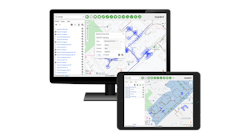Subway Wireless Network Build Leads the Way for Smart City Efforts —
The New York City subway system is the United States’ largest transportation network, operating 24 hours a day, 365 days a year. But just a few years ago, more than 5.5 million riders who rely upon the subway system every day, had no access to cellular and Wi-Fi connectivity while traveling underground. A high-speed communications and IP infrastructure was needed to not only keep riders connected but also to support public safety and emerging smart city technologies.
Commuters in New York City stay connected with cellular and Wi-Fi service within all underground subway stations.
The Process
In 2007, Transit Wireless was selected through a public-private partnership to finance, design, build, operate and maintain a shared wireless infrastructure in all New York City underground subway stations. Public-private partnerships like this are a growing trend in funding urban infrastructure projects, as they are a way for private companies to contract with government entities while mitigating costs to the public. It’s a win-win-win for consumers, governments and private companies and that is why public-private partnerships or P3s are now providing infrastructure improvement for cities around the world.
Designing and building wireless infrastructure in subway stations was no easy task. With harsh environmental conditions such as high heat, moisture and water intrusion, customized equipment was required. There were also many structural challenges, such as low ceilings and narrow platforms. Around-the-clock train traffic also restricted the hours during which construction could take place. Ensuring the safety of subway riders during construction was the foremost concern, as well as keeping any service delays to a minimum.
The entire design and build of a neutral host DAS and Wi-Fi network took 5 years. The project began in 2011. A DAS and Wi-Fi network is complementary and offers many advantages including the ability to deliver wireless technologies including GSM, CDMA, EVDO, UMTS, and LTE, in conjunction with any Tier One wireless carrier. Neutral host DAS wireless installations are readily scalable to meet growing demands on a network and future technologies such as Wi-Fi 6, 5G, and Citizens Broadband Radio Service (CBRS).
Free Wi-Fi is available throughout all New York City underground subway stations through the Transit Wireless network.
The project build was split into phases, allowing our team the ability to gain familiarity with the subway’s landscape and adjust our plans accordingly. As an example, in the initial build, each station was built almost as a modular network. For the next 6 phases, our engineers had learned that a typical station actually only needed one Radio Frequency Nozzle (RFN) each. This change cut the build time needed for each station tremendously. Another adjustment was changing the mounting tabs on the Access Point (AP) Boxes and applying higher-powered RFNs to improve wireless signal. Applying what we learned at every stage of the process made the project much less costly and more efficient.
In December 2016, the installation of Wi-Fi and cellular service in all New York City underground subway stations was completed nearly 2 years ahead of schedule. In total, the network now extends across all 283 underground subway stations in the 4 boroughs the subway reaches.
The popularity and demand for the public Wi-Fi network and cellular coverage has continued to grow since the project’s completion. In the first year of system-wide service, more than 280 million cellular calls originated within the underground subway stations, and 120 million Wi-Fi log-ins were made to the public Wi-Fi network. Connectivity is one of the most important aspects of the customer experience and subway riders get fast wireless connectivity through the Transit Wireless Wi-Fi and DAS network.
Since the initial build of the Transit Wireless network, 450 train arrival countdown clocks have been added throughout the New York City subway system.
A Network for Safety and Smart City Initiatives
We have been adding public safety initiatives and increased communications continues to be an evolving goal of the network. Since the initial build, 450 train arrival countdown clocks have been added throughout the underground system. These systems use train-mounted Bluetooth® technology to relay train arrival and departure information through the network to predict when the next train will arrive based on the collected data.
The network also has cellular capability that enables public safety authorities to pinpoint the location of the underground station in the event of an emergency. More than 3,000 help point kiosks in stations are also supported by the network allowing for instant communications with emergency services.
Our network is available and ready for additional applications in New York City and beyond. The eventual extension of wireless connectivity into the tunnels and onboard the trains could allow for communications-based train control and diagnostic technologies to be placed on the trains for predictive maintenance for the benefit of the conductors, engineers and customers. With the installation of other autonomous sensors, applications to monitor key components of the subway stations, including elevators, escalators and waste receptacles can also be easily integrated. These applications could be managed right from a station agent’s mobile device and include camera systems, motion and environmental sensors, access controls and passenger information systems.
Like this Article?
Subscribe to ISE magazine and start receiving your FREE monthly copy today!
What was once seen as an enhancement of subway riders’ experience has evolved to become an essential part of daily ridership. Our team at Transit Wireless is proud to demonstrate what is possible when the nation’s largest city gets connected and we look forward to pushing for the future evolution of New York as a smart city.








